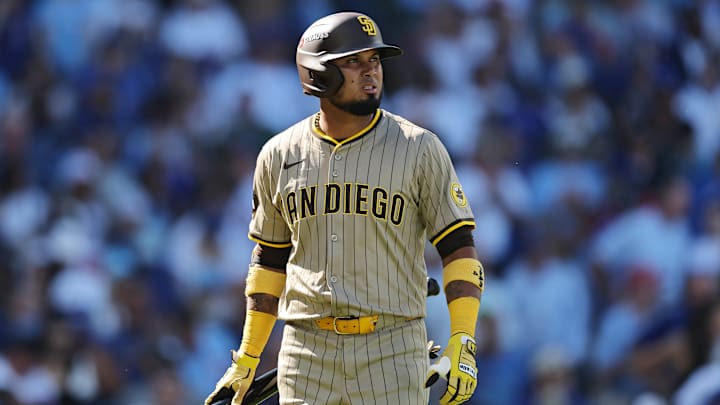The San Diego Padres’ early exit only underscored what most of 2025 kept hinting at: this roster needs more damage in the lineup and more bankable innings in the rotation. Five runs across three games won’t cut it in October, and neither will the constant scramble to cover starter workload with a bullpen serving as Band-Aids.
Budget-wise, San Diego isn’t in a position to paper over every leak with premium contracts. They have to get sharper, not just louder, prioritizing durability on the mound, run prevention on the edges, and a real middle-order threat that changes how opponents pitch to their stars. That’s why some familiar names won’t be back. The calculus is part health, part role fit, and part dollars.
5 Padres players who definitely won't be back in 2026 after early playoff exit
SP Nestor Cortes
The early exit only sharpened San Diego’s biggest need: reliable, healthy innings. Cortes didn’t provide that. After logging just two starts in Milwaukee before an IL stint, he made six for the Padres, hit the shelf again, and wasn’t healthy enough to make the postseason roster. That’s not a rental that earns a second contract.
He hits free agency going into his age-31 season, and any deal would be a bet that the durability issues are behind him. The Padres have little incentive to make that bet when they need steadier volume and have cheaper in-house alternatives to soak up back-end starts. If they spend, it’ll be on a sturdier mid-rotation arm — or on bats, rather than a bounce-back play on a soft-tossing lefty with recent availability concerns.
1B/OF Ryan O’Hearn
After an anemic October, San Diego needs flexibility and run prevention more than another left-handed 1B/DH. O’Hearn’s projected market (~$11.4M AAV) prices him out of a bench-bat role and duplicates skills the Padres already have.
Dansby with a dazzling catch to keep this a one-score game. pic.twitter.com/2ubXWrmnvT
— Chicago Cubs (@Cubs) September 30, 2025
The cleanest path is sliding Gavin Sheets to his natural spot at first base, where the glove plays up and the bat is easier to live with. Even through an uneven 2025, Sheets delivered a solid breakout (.252/.317/.429, 19 HR, 71 RBI) and his first positive WAR season (0.7) — exactly the kind of affordable upside you bank on. He enters his second year of arbitration and will be a much cheaper affordable first base option. It’ll fill O’Hearn’s plate appearances without his price tag, and it frees the Padres to target a right-handed power bat instead of paying starter money for a bat-only platoon fit.
1B/2B Luis Arraez
The Padres’ October showed it plainly: they need more impact, not more singles. Arraez remains the game’s cleanest bat-to-ball artist, but his 2025 line (career-low .292 average, 1.3 WAR, 8 HR, 61 RBI over 154 games) underscores the roster fit problem. When your lineup lacked carry all year, a contact-first 1B/2B with limited defensive value becomes a luxury, not a necessity.
He’s also set to reach free agency for the first time, and a projected price tag around $14.5M AAV pays for on-base skill more than damage. San Diego’s dollars are better aimed at a true middle-order thumper and more run prevention — especially if Gavin Sheets slides to first base and the front office hunts a right-handed power bat. Arraez’s elite floor helps plenty of teams; the Padres, specifically, need ceiling.
SP Dylan Cease
The issue isn’t stuff; it’s value. Cease’s swing-and-miss remained loud (29.8% K rate), but the 9.8% walk rate and constant pitch-count battles kept him in traffic and limited his efficiency. The result was a rough line (8–12, 1.1 WAR, his lowest since 2020), which is hard to square with a projected $26.4M AAV — nearly double his prior $13.7M. In a tight budget cycle after an early exit, that’s top-of-rotation money for mid-rotation results.
San Diego needs bankable innings and fewer self-inflicted jams. Committing that kind of cash to volatility would crowd out two smarter bets: a mid-tier upside play (the Nick Pivetta archetype) and another durable arm for length. Internally, the Padres can cover back-end volume with Randy Vásquez now and push JP Sears, using free-agent dollars to add one reliable stabilizer rather than chasing ceiling at premium cost.
SP Michael King
The Padres’ early exit puts every dollar under a microscope, and that’s bad news for a mutual option. King has a $15 million mutual for 2026, but these are almost never exercised — players with ace stretches usually test free agency for multi-year security, and clubs prefer flexibility.
When King was right, he looked like a Cy Young candidate, precisely why he’ll bet on himself on the open market. The flip side is availability and workload management, which make a one-year pact risky from the team’s perspective and a multi-year guarantee attractive from the player’s. San Diego’s recent addition of JP Sears reads like a hedge: not a 1:1 replacement for King or Cease, but a controllable starter who stabilizes the floor while they shop for a mid-rotation value.
This isn’t a tear-down; it’s a reset. Letting these five walk frees San Diego to target the pieces the postseason exposed, one right-handed impact bat, two sturdier starters, and better defense on the margins. If they spend with discipline and let their young arms push, the 2026 Padres can raise the floor and the ceiling.
